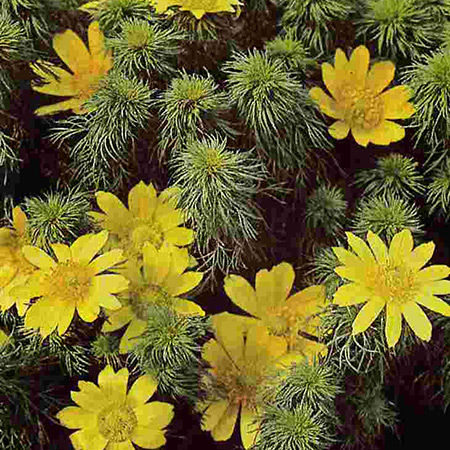Botanical name
Adonis vernalis L.
Family
Ranunculaceae
Common name
Pheasant’s eye, Spring adonis, Spring pheasant’s eye, Yellow pheasant’s eye, Bird’s eye
Information about the plant
The Pheasant’s eye (Adonis vernalis) is a Euro-Siberian steppe plant (poisonous!), which has become rare in Central Europe. In Germany, it only grows on the banks of the Vistula, Oder, Main and Rhine rivers. The populations are declining and are under conservation protection.
In Greek mythology, Adonis was the mortal lover of the goddess Aphrodite. One day, Adonis was gored by a wild boar during a hunting trip and died in Aphrodite’s arms as she wept. His blood mingled with her tears and became the blood-red anemone flowers. From Aphrodite’s tears came blood-red flowers, the Adonis roses. Therefore, the name Adonis vernalis for the yellow-flowered spring Adonis can only be understood if one knows that there are also red-flowered species.
Adonis vernalis is a perennial plant, reaching 10 to 40 cm in height. The entire stem is covered with two to four pinnate leaves, each having very narrow-linear pinnae with downwardly bent tips. At the end of the stem, there is a flower 4 to 7 cm in diameter with 10 to 20 lemon-yellow petals. In the centre of the flower, numerous stamens are arranged in a tight circle around the ovary. This formation resembles an eye, which is why the plant is also known in German as "Teufelsauge”, translated as “devil's eye". Adonis vernalis blooms in spring, typically in April/May.
Medicinally used parts of plants (herbal drug)
The whole plant, particularly the leaves, flowers and stems (Adonis herb - Adonidis herba) is harvested during the flowering period.
The commercial drug is sourced from Eastern Europe and Russia.
Constituents of the herbal drug
The constituents of Adonis vernalis that might be relevant for consumer safety are the pharmacologically active cardenolides (cardiac glycosides). The total cardenolide content of the above-ground parts of the plant is reported to be 0.2 % to 1.0 % in the dry matter. About 30 cardenolides derived from 5 genera have been identified. The main glycosides of the total cardenolides are adonitoxin (15 to 20 %), which is an isomeric form of convallatoxin, cymarin and k-strophanthoside. Further constituents in the dried herb and flowers of Adonis vernalis are flavone C-glycosides (about 1 %).
Quality of the drug
The quality of the Adonis herb (Adonidis herba) and the standardized Adonis powder (Adonidis pulvis normatus) was specified in the German Pharmacopoeia (DAB) until 2014. The European Pharmacopoeia contains a quality specification for "Adonis vernalis for homeopathic preparations".
Medical applications
Recognised medical use
Adonis herb has not been evaluated by HPMC or ESCOP.
Traditional use
Due to the content of cardiac cardenolides, which are responsible for the plant’s toxicity, classifying the Adonis herb as a traditional herbal medicinal product under the § 39a AMG is not possible.
Herbal drug preparations in finished dosage forms
Adonis herb is a component of homeopathic heart remedies, used in combination with other heart-active drugs (including hawthorn, sea squill, lily of the valley, strophanthus). These preparations include:
Adonis vernalis homeopathic mother tincture
Adonis vernalis homeopathic dilutions D2 and D4
Dosage
Finished medicinal product: see package insert leaflet
Tea: Due to the narrow therapeutic range of the Adonis herb (poisonous effect of its cardenolides!), tea should not be used.
Preparation of a tea
Not applicable
Notes
For treatment with Adonis herb, medical advice must be obtained. Adonis herb is not allowed to be used during the treatment with digitalis cardiac glycosides and during potassium deficiency states.
Adonis herb should not be taken during pregnancy and lactation. It should also not be used in children and adolescents under 18 years of age.
Side effects
The most common side effects are nausea, vomiting and cardiac arrhythmia.
Interactions
Increase in efficacy and, thus, side effects with concomitant administration of quinidine, calcium, laxatives, and alongside long-term corticosteroid therapy.
Further literature
Commentary on the German Pharmacopoeia (Adonis vernalis für homöopathische Zubereitungen, Nr. 2832)


